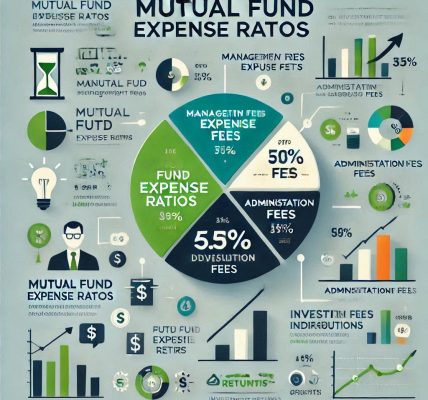Introduction
Investing in mutual funds can be a great way to grow wealth over time, but choosing the right fund requires careful analysis. With hundreds of mutual funds available, investors must evaluate various metrics and ratios to make informed decisions.
In this guide, we will break down the key metrics and ratios used to analyze mutual funds and explain how they impact investment decisions.
1. Expense Ratio
What is it?
The expense ratio represents the annual cost of managing a mutual fund as a percentage of total assets. It includes management fees, administrative costs, and operational expenses.
Why is it important?
- A lower expense ratio ensures that more of your investment remains in the fund, compounding over time.
- Actively managed funds typically have higher expense ratios than passively managed index funds.
Ideal Range:
- Index Funds & ETFs: 0.10% – 0.50%
- Actively Managed Funds: 1.00% – 2.00%
2. Net Asset Value (NAV)
What is it?
NAV represents the per-unit price of a mutual fund and is calculated as:
Why is it important?
- It reflects the market value of a fund’s holdings.
- Unlike stock prices, a lower NAV doesn’t necessarily mean a better investment; returns matter more.
3. Past Performance & Annualized Returns
What is it?
Annualized returns measure the fund’s average returns over a period (1 year, 3 years, 5 years, etc.).
Why is it important?
- It helps investors gauge consistency in performance.
- While past performance does not guarantee future returns, consistent outperformance is a positive sign.
Ideal Benchmark:
Compare fund returns against an appropriate benchmark index (e.g., NIFTY 50, S&P 500).
4. Standard Deviation (Volatility Measure)
What is it?
Standard deviation measures how much a mutual fund’s returns deviate from its average return.
Why is it important?
- Higher standard deviation means higher volatility (risk).
- Suitable for investors with different risk appetites.
Ideal Range:
- Low Volatility Funds: 5% – 10%
- Moderate Volatility Funds: 10% – 20%
- High Volatility Funds: Above 20%
5. Sharpe Ratio
What is it?
Sharpe ratio evaluates the risk-adjusted return of a mutual fund:
Why is it important?
- A higher Sharpe ratio indicates better risk-adjusted returns.
- Helps investors compare funds with similar returns but different risk levels.
Ideal Range:
- Above 1.0 – Good risk-adjusted performance
- Above 2.0 – Excellent risk-adjusted performance
6. Alpha
What is it?
Alpha measures a fund’s ability to generate excess returns relative to its benchmark.
Why is it important?
- A positive alpha means the fund has outperformed its benchmark.
- A negative alpha indicates underperformance.
Ideal Range:
- Positive Alpha (above 0%) – Indicates superior fund management
7. Beta (Market Sensitivity)
What is it?
Beta measures a mutual fund’s sensitivity to market movements.
Why is it important?
- Beta = 1: Moves in line with the market.
- Beta < 1: Less volatile than the market (good for conservative investors).
- Beta > 1: More volatile than the market (higher risk, higher potential return).
Ideal Consideration:
- Conservative investors: Choose low-beta funds.
- Aggressive investors: Can consider high-beta funds for higher returns.
8. Portfolio Turnover Ratio
What is it?
Portfolio turnover ratio indicates how frequently a fund’s assets are bought and sold.
Why is it important?
- A high turnover ratio means more frequent trading, leading to higher transaction costs.
- Actively managed funds often have higher turnover ratios.
Ideal Range:
- Below 50%: Indicates a stable, long-term strategy.
- Above 100%: Suggests frequent trading (higher costs).
9. Asset Allocation & Holdings
What is it?
Asset allocation shows how a mutual fund invests across different asset classes (stocks, bonds, cash, etc.).
Why is it important?
- Helps determine the fund’s risk exposure.
- Investors should align allocation with their risk tolerance.
Key Considerations:
- Equity-heavy funds: Higher risk, higher potential returns.
- Debt-heavy funds: Lower risk, stable returns.
- Hybrid funds: Balanced risk-reward approach.
10. Fund Manager’s Track Record
Why is it important?
- A skilled fund manager plays a critical role in fund performance.
- Investors should review the manager’s experience and past performance in handling funds.
Conclusion
Analyzing a mutual fund requires looking beyond past returns and considering multiple key metrics such as expense ratio, risk measures, alpha, beta, and asset allocation. By understanding these factors, investors can select mutual funds that align with their financial goals and risk tolerance.
Before investing, it is recommended to consult with a financial advisor to make well-informed decisions.
Disclaimer: This article is for informational purposes only and does not constitute financial advice. Investors should conduct their own research or consult a certified financial advisor before making investment decisions.




